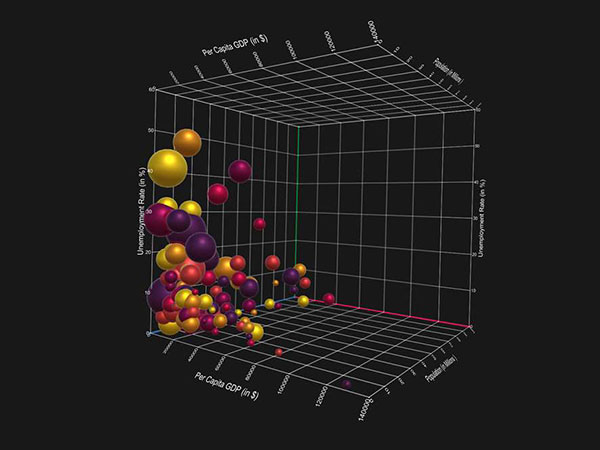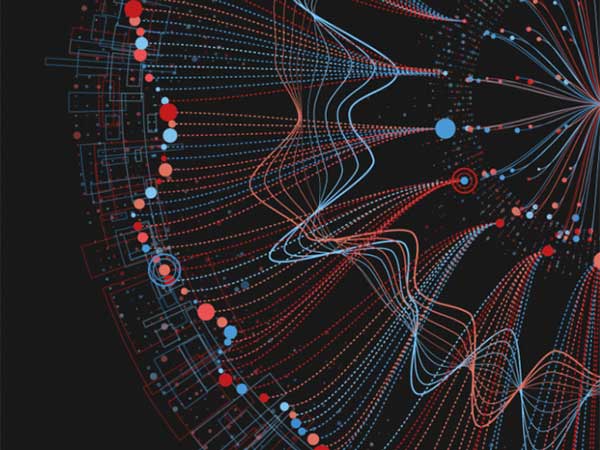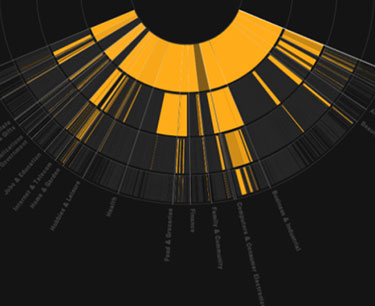This list of top 30 thought leaders in Data Visualization is based on recommendations and opinions by visualization experts in various social media channels. The names are listed alphabetically.
1. Aaron Koblin
Aaron Koblin is a digital media artist, best known for his innovative use of data visualization and his pioneering work in crowdsourcing and interactive film. In 2006, his “Flight Patterns” (his influential visualization of a single day’s air traffic over the United States) received the National Science Foundation’s first place award for science visualization. In 2014, Koblin was awarded the National Design Award for Interactive Design. He is currently Creative Director of the Data Arts Team at Google.
2. Alan M. MacEachren
Alan MacEachren is the author of “How Maps Work”, which presents an integration of cognitive and semiotic approaches to provide an understanding of maps and their applications for geographical visualization. He is known for his cross-disciplinary work in the fields of human-centred geographic visualization, scientific and information visualization, and in statistics.
3. Alberto Cairo
Author The Functional Art: An Introduction to Information Graphics and Visualization, Alberto Cairo led the El Mundo.es infographics team in the early 2000s, when they and their Madrid rivals El Pais were creating some of the most innovative and sophisticated online graphics in the industry. He taught information graphics and design at the journalism school of the University of North Carolina, where he oversaw a number of standout multimedia projects and authored the handbook “lntogratia 2.0”, a guide to infographics and cartography. Since 2004, he has co-instructed the workshop in online infographics at the University of Navarre in Spain. In 2009 he joined the Brazilian magazine publishing firm Globo as their director of infographics. He teaches visualization at the University of Miami.
4. Alvaro Valino
Alvaro is an infographic artist, illustrator and graphic designer from A Coruña, Galicia. He was part of a five-person team creating information graphics at the Spanish newspaper Publioo. The paper’s spare and clean graphic style and ambitious data visualizations netted it 21 medals at the Malofiej awards in 2010, all the more impressive given that the paper was only in its second year of publication. Interestingly, the Publico team has applied a data vis-heavy approach to not only business and hard news stories, but to arts, sports and culture stories, such as graphics exploring EdgarAllen Poe’s literary legacy and Paul Newman’s career.
5. Amanda Cox
Amanda Cox received her M.S. in statistics from the University of Washington in 2005. She then moved to the New York Times, where she is a graphics editor. She, and the graphics team at the New York Times, are responsible for many of the cool, informative, and interactive graphics produced by the Times. She frequently uses the statistical applicationR to plot data sets— often using algorithms developed in the academic world—then outputs them either as line art for print publication, or she works with her colleagues to translate them into Flash code for interactive presentations.
6. Ben Shneiderman
Ben Shneiderman is a computer scientist. He conducted fundamental research in the field of human–computer interaction, developing new ideas, methods, and tools such as the direct manipulation interface, and his eight rules of design. His major work has been on information visualization, originating the treemap concept for hierarchical data. He also developed dynamic queries sliders with multiple coordinated displays that are a key component of Spotfire, which was acquired by TIBCO in 2007. His information visualization mantra “overview, zoom and filters, and details-on-demand” is one of the most famous mantra in visualization.
7. Benjamin Fry
Benjamin Fry is an expert in data visualization and the author of the book “Visualizing Data“ (2007), which offers detailed step-by-step instructions for creating some of his most well-known visualizations. At the MIT Media Lab, he co-developed the open-source programming tool “Processing” with Casey Reas. Processing provides a simple, accessible interface for non-programmers to harness the graphics generation capabilities of the Java programming language.
8. Colin Ware
Author of “Information Visualization” and “Visual Thinking”, Colin Ware is the director of the Data Visualization Research Lab at the University of New Hampshire. Ware specializes in advanced data visualization and has a special interest in applications of visualization to Ocean Mapping. He combines interests in both basic and applied research and he has advanced degrees in both computer science (MMath, Waterloo) and in the psychology of perception (PhD,Toronto). Ware has published over 140 articles in scientific and technical journals and leading conference proceedings. Many of these articles relate to the use of color, texture, motion and 3D displays in information visualization.
9. David McCandless
David McCandless is a London-based author, independent data journalist and information designer. He published “Information is Beautiful” in 2009 and it features 20 new visualizations and over 20 updated infographics. It’s now available in over 10 languages, including Spanish, French, Italian, Chinese and Korean.
10. Edward Tufte
Edward Tufte is a statistician and professor emeritus of political science, statistics, and computer science at Yale University. He is noted for his writings on information design and as a pioneer in the field of data visualization.
11. Eric Rodenbeck
Eric Rodenbeck is a partner in Stamen Design, an influential visualization and interactive design firm in San Francisco, which designs applications and visualizations for clients like MTV, MSNBC, NBC Sports, the London 2012 Olympic Committee, Trulia and others. Stamen’s work focuses frequently on visualizing live data streams, such as Twitter activity around entertainment events, or crime data from Oakland and San Francisco. Stamen is a winner of the 2010 Knight News Challenge for a project called “Citytracking”, which is intended to help users create visualizations from municipal data.
12. Fernanda B. Viégas
Fernanda B. Viégas is a computational designer whose work focuses on the social, collaborative, and artistic aspects of information visualization. She is a co-leader, with Martin Wattenberg, of Google’s “Big Picture” data visualization group in Cambridge, MA. Before joining Google, she and Wattenberg founded Flowing Media, Inc., a visualization studio focused on media and consumer-oriented projects. Viegas is known for using visualization to explore social interchanges in email, chat histories and Wikipedia edit trails.
13. George Robertson
George Robertson is a visualization expert and Senior Researcher, Visualization and Interaction (VIBE) Research Group, Microsoft Research. With Stuart K. Card, Jock D. Mackinlay and others he invented a number of Information Visualization techniques, e.g. the Cone Trees that inspired many researchers including Jeff Heer and Tamara Munzner to be interested in data visualization.
14. Hannah Fairfield
Hannah Fairfield is the graphics editor of The New York Times. In recent years, she produced the innovative “Metrics” column, a large-format information graphic in the Times’ Sunday business section. With relatively long lead times, she was able to experiment with new graphic forms and sophisticated data presentations of subjects like home foreclosures, unemployment and the difference in salaries between male and female workers.
15. J. Paige West
Director of MSNBC’s Interactive Studio, Paige West leads 11 online producers to develop all of the interactive multimedia for the “top global news site.” The Interactive Studio creates multimedia and interactive features for one of the most popular U.S. news websites, as well as and tools and templates for producers throughout the MSNBC.com newsroom. In 2009, MSNBC bought the hyper-local data aggregator Everyblock.com opening the door to blending highly detailed local information with MSNBC’s nationally-focused news.
16. Jeffrey Heer
Jeffrey Heer is a prolific contributor to the field of information visualization. He led the development of three open source toolkits designed to ease the process of creating visualizations: Prefuse (2004), Flare (2008) and Protovis (2009). Heer is also interested in the social interactions around visualization; in 2006 he worked with the IBM researchers Martin Wattenberg and Fernanda Viégas to create Sense.us, a collaborative visualization tool that allowed users to mark and comment on historical employment data from the U.S. Census Bureau.
17. Jock McKinlay
Jock McKinlay is a visualization expert and Director of Visual Analysis at Tableau Software. With Stuart K. Card, George G. Robertson and others, he invented a number of Information Visualization techniques.
18. John Grimwade
John Grimwade is a respected information graphics designer and educator. He is the longtime graphics director for Condé Nast Traveler, and was shared with Portfolio Magazine during its brief run that ended in 2009. He has produced infographics for more than 30 major magazines and several books. Before moving to the United States, he worked for 14 years in newspapers in London (including six years as head of graphics at The Times). He co-hosts the annual Malofiej “Show Don’t Tell” infographics workshop in Pamplona, Spain, and teaches information graphics at the School of Visual Arts in Manhattan.
19. Kim Rees
Kim Rees is a co-founder of Periscopic, an award-winning information visualization firm. An award winner in the VAST 2010 Challenge, Kim is a prominent individual in the information visualization community and she has published papers in Parsons Journal of Information Mapping.
20. Martin Wattenberg
Martin Wattenberg is a prominent visualization researcher and artist, known for influential works such as the Baby Name Voyager (2005) and the SmartMoney Map of the Market (1998). He is a co-leader of Google’s “Big Picture” data visualization group. Wattenberg spent five years at IBM Research, during which time he co-developed the public visualization tool ManyEyes.
21. Mike Bostock
Mike Bostock is a Graphics Editor at Nytgraphics and author of D3.js and prior to that Protovis.js. He does infographic work for the New York Times, as well as many other things.
22. Nicholas Felton
Nicholas Felton is an infographic designer. He is the author of several Personal Annual Reports that weave numerous measurements into a tapestry of graphs, maps and statistics to reflect the year’s activities. His clients include CNN, The Wall Street Journal New York Magazine and Wired. Since 2005 he has been publishing personal “annual reports” of his year made with statistical ephemera. In this vein, he co-founded the web service Daytum.com which he describes as “a site for counting and communicating daily data.” His most recent product is Reporter, an iPhone app designed to record and visualize subtle aspects of our lives.
23. Nigel Holmes
Nigel Holmes is a British graphic designer and theorist, who focuses on information graphics and information design. The former graphics director of Time Magazine, Nigel Holmes is known for tackling complex and difficult subjects — the Iraq war, the economic crisis, for example— in ways that are clear and engaging. He is a frequent contributor to publications like Good Magazine, The New York Times Op—Ed page, Wired and the Atlantic Monthly.
24. Ola Rosling
Ola Rosling is director and co-founder of Gapminder Foundation and previously was the product manager of Google Public Data. Rosling joined Google in 2007, after its purchase of Gapminder. Google incorporated Gapminder’s “Trendalyzer” technology for creating animated bubble plots into its online spreadsheet tools and into a product called Public Data Explorer.
25. Richard Koci Hernandez
Richard Koci Hernandez is an Emmy award winning video and multimedia producer and worked as a photo journalist at the San Jose Mercury News for 15 years. His work has appeared in Time, Wired, The New York Times, a National Geographic book and international magazines. In 2008, Richard was awarded a national Emmy award for the New Approaches to Documentary category for his executive producer work on the Mercury News video entitled, Uprooted. In 2011 Koci Hernandez was named an Assistant Professor for New Media at the Graduate School of Journalism at UC Berkeley.
26. Scott Byrne-Fraser
Scott Byrne-Fraser is currently the Creative Director of the BBC Sport digital products. He manages a team of about eight designers, eight journalists and four developers who create maps, infographics, charts and data visualizations. Over the last two years and a half years he has built led the BBC’s Sport’s UX&D team in their new home in MediaCityUK. Before that Scott spent eight years working as a UX designer in the newsrooms of BBC News and on broadcast at Sky News.
27. Stephen Few
Stephen Few is the author of three popular books: Show Me the Numbers, Information Dashboard Design, and Now You See It: Simple Visualization Techniques for Quantitative Analysis. Through his consultancy Perceptual Edge, Stephen teaches simple, clear, and practical data visualization techniques for analyzing and presenting quantitative information.
28. Stephen Kosslyn
Stephen Michael Kosslyn is a psychologist and neuroscientist, who specializes in the fields of cognitive psychology and cognitive neuroscience. Kosslyn works on visual display design, showing how psychological principles can be used to produce displays that can be read at a glance. Most recently, he has extended this work to show how psychological principles of perception, memory, and comprehension can be used to make and deliver effective PowerPoint presentations.
29. Steve Duenes
Steve Duenes is the graphics director of The New York Times, a position he has held since 2004. He came to the Times in 1999 as the graphics editor for the science section, and was promoted to deputy graphics director in 2001. He oversees the newspaper’s graphics department, which has a staff of nearly 30 graphics editors doing reporting, 2D and 3D illustration, programming, interactive design, data analysis and cartography. The group developed an online graphics capacity to match its reputation in print, with an array of new tools, templates, interface conventions and code libraries.
30. Thomas Molén
Thomas Molén is a visual journalist for Svenska Dagbladet (Stockholm). His online graphic showing voting patterns in Eurovision Song Contest won the Peter Sullivan/Best of Show award in this year’s Malofiej competition.














